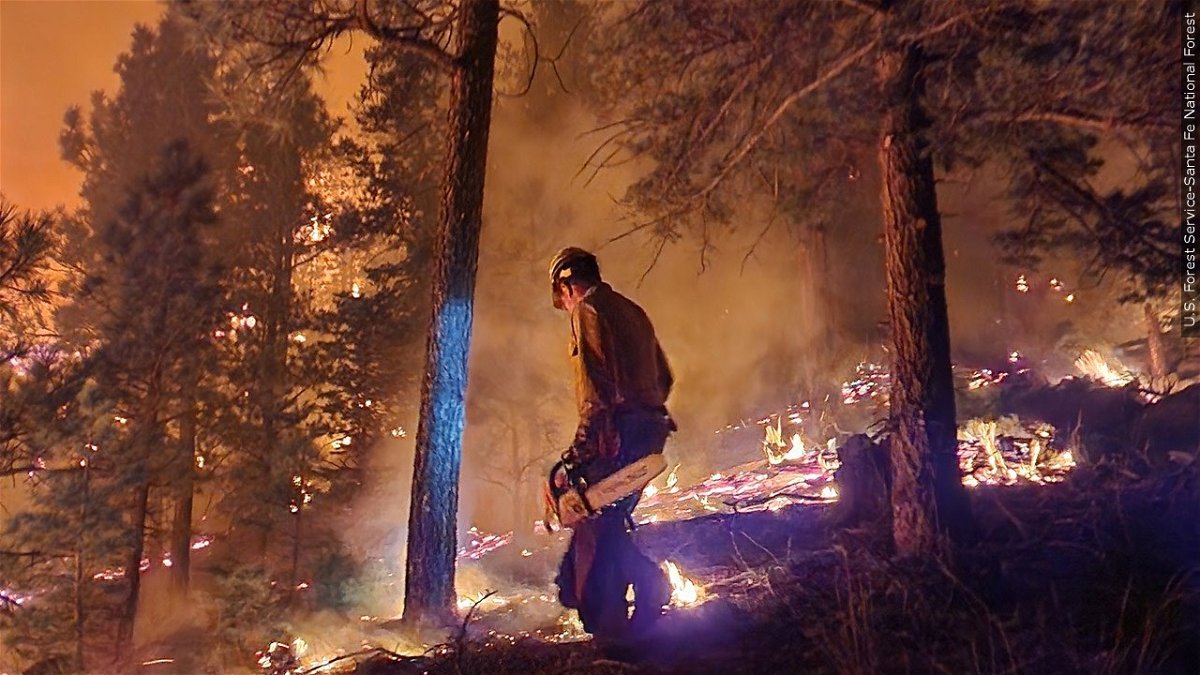Massive New Mexico blaze blamed on miscalculations, errors

By SUSAN MONTOYA BRYAN
Associated Press
ALBUQUERQUE, N.M. (AP) — U.S. Forest Service employees made multiple miscalculations, used inaccurate models and underestimated how dry conditions were in the Southwest, causing a planned burn to reduce the threat of wildfires to explode into the largest blaze in New Mexico’s recorded history, the agency said Tuesday.
The agency quietly posted an 80-page review that details the planning missteps and the conditions on the ground as crews ignited the prescribed fire in early April. The report states officials who planned the operation underestimated the amount of timber and vegetation that was available to fuel the flames, the exceptional dry conditions and the rural villages and water supplies that would be threatened if things went awry.
Within hours of declaring the test fire a success that day, multiple spot fires were reported outside containment lines and there were not enough resources or water to rein them in.
“The devastating impact of this fire to the communities and livelihoods of those affected in New Mexico demanded this level of review to ensure we understand how this tragic event unfolded,” U.S. Forest Chief Randy Moore wrote. “I cannot overstate how heartbreaking these impacts are on communities and individuals.”
As of Tuesday, the blaze had charred more than 533 square miles (1,380 square kilometers), making it the largest fire to have burned this spring in the U.S. It comes during a particularly ferocious season in which fire danger in overgrown forests around the West has reached historic levels due to decades of drought and warmer weather brought on by climate change.
The number of acres burned so far this year is more than two and half times the national average for the past 10 years, according to the National Interagency Fire Center. So far, 31,000 wildfires have burned more than 5,000 square miles (12,950 square kilometers) in the United States.
Anger and frustration have been simmering among residents and elected officials in northern New Mexico, where hundreds of homes have been destroyed and thousands of residents were displaced.
Many mountainsides have been reduced to ash and once towering ponderosa pine trees have been turned into charred toothpicks. Spots considered sacred by the ranching and farming families who have called the region home for generations have been wiped out.
U.S. Rep. Teresa Leger Fernández called the Forest Service review incredibly disturbing, pointing to the use of outdated data to plan for the prescribed burn and the “cascade of errors” that followed.
She said the failures of the Forest Service destroyed many rich and proud New Mexico communities.
“These are complex issues. Starting a prescribed burn in an area where there are homes and watersheds and communities should be something that you take incredibly serious because those are high value assets,” she said. “They did not value the resources, the communities, the historic nature of these communities and so they went forward allowing more risk than they should have.”
Leger Fernández also said threats of a second disaster are looming with rainfall expected over the burn scars.
As a result of the fire, the Forest Service in May suspended prescribed burn operations across the U.S. pending its own nationwide review that will identify the need to update protocols, policies or procedures based on changing conditions due to drought and climate change.
The report on the New Mexico fire stated that the crew members believed they were within the approved limits for the planned burn and had a plan to construct a line where they could check the fire’s progress and cease ignitions if the parameters were exceeded.
But the fire was burning in much drier conditions than the crew understood, according to the Forest Service’s analysis of fuel and weather information.
“Persistent drought, limited snow and rain, fine fuel accumulation, and fuel loading from burn unit preparation all contributed to increasing the risk of escape,” the report stated.
A mix of spot weather forecasts and on-site observations were the only methods of weather collection used. The days preceding the ignition of the prescribed fire were described as a “weather roller coaster,” and the agency said more data should have been used to assess the conditions.
The report also said managers failed to accurately assess the complexity of the planned burn, providing a picture that indicated risks has been reduced when in fact that wasn’t the case.
The prescribed burn was part of a plan first adopted in 2019 to reduce the risk of wildfire in the Gallinas Watershed. New Mexico Gov. Michelle Lujan Grisham said she was frustrated that Forest Service planning documents related to the project were re-approved each year since then without adjustments being made to account for the worsening drought.
She said in a statement that it does not appear anyone involved in the burn was being held accountable for what she called “significant mistakes.”
It was not immediately clear whether the Forest Service has taken any disciplinary actions, but the report includes proposed recommendations to improve policies and performance.
The report states that on several occasions before and after a test fire ahead of the prescribed burn was lit, some personnel felt that the dry conditions would result in higher risk but they accepted the assignment.
Leger Fernández said her request for an independent investigation has been approved. It will look at federal prescribed fire policies nationwide.
President Joe Biden recently flew over the fire and stopped briefly in New Mexico to assure residents the federal government would take responsibility for its role in causing the blaze.
